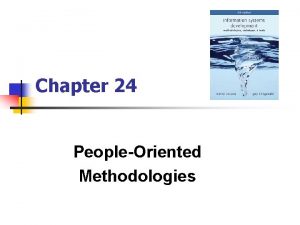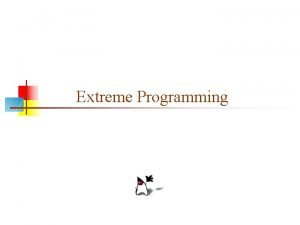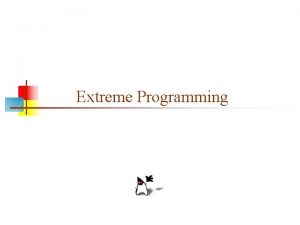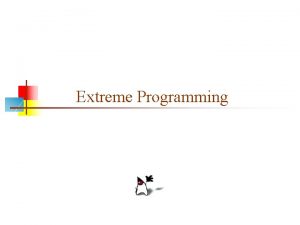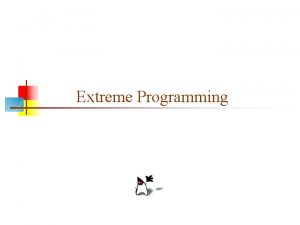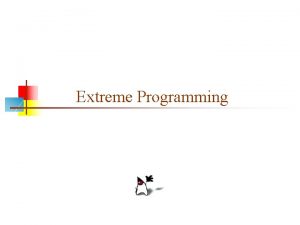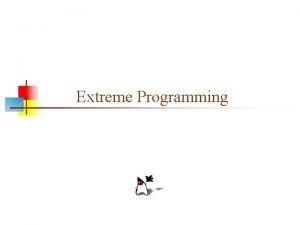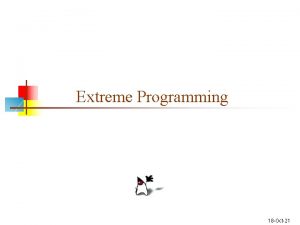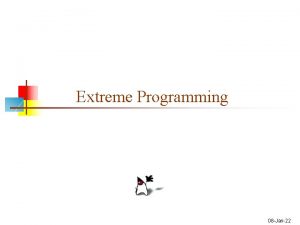Extreme Programming Software engineering methodologies n n A















- Slides: 15

Extreme Programming

Software engineering methodologies n n A methodology is a formalized process or set of practices for creating software An early methodology was the waterfall model, so named because each stage flowed into the next, with no backing up to a previous stage n n n The stages were: Requirements Design Implementation Verification Maintenance The waterfall model has never been regarded as a “good” model Methodologies are subject to fads, and are frequently imposed on programmers by management n n n Some methodologies are bad—even ridiculously bad This doesn’t mean all methodologies are bad However, a single methodology doesn’t work for all cases 2

Agile programming methodologies n There are (at least) two serious problems with the waterfall model: n n n It assumes that there will be no unforeseen difficulties in the software development It assumes that the customers know (and can specify) what they want, in extreme detail Agile programming methodologies (of which there are several) assume: n Customers can best discover what software meets their needs via frequent iterations n n Hence, communication between customers and developers is vital Requirements will need to be revised, probably multiple times, during software development 3

Extreme programming n n In this course we will draw on a number of ideas from one particular agile methodology, Extreme Programming (XP) The basic idea of extreme programming is to take to an extreme each of several known good practices n n For example, it is well known that software should be tested frequently during development n n “The first time I was asked to lead a team, I asked them to do a little bit of the things I thought were sensible, like testing and reviews. The second time there was a lot more on the line. I thought, "Damn the torpedoes, at least this will make a good article, " [and] asked the team to crank up all the knobs to 10 on the things I thought were essential and leave out everything else. ” — Kent Beck Extreme programming advocates testing code literally every few minutes, after every minor change Extreme programming works best for relatively small projects with a small number of good programmers 4

XP values n Communication n n Simplicity n n From the system: Unit tests From the customer: Acceptance tests From the team: Estimate the time to implement new requirements Courage n n Follow the KISS principle (“Keep It Simple, Stupid!”) Feedback n n Use simple designs and common metaphors, talk continuously with your programmers and customers Code for today, not tomorrow Refactor as appropriate Be willing to throw code away Respect n Trust your team members not to submit nonworking code 5

XP practices n The XP practices we will emphasize are: n Pair Programming n n Test Driven Development n n Learn and follow well-established conventions Collective Code Ownership n n Putting code together as you write it, not at the last minute Coding Standards n n Writing lots of tests, and writing them early Continuous Integration n n Teams of two people You are responsible for your partner’s code Simple Design n Eschew obfuscation Source: http: //en. wikipedia. org/wiki/Extreme_programming 6

Pair programming is. . . n TWO programmers working side-by-side, collaborating on the same design, algorithm, code or test. One programmer, the driver, has control of the keyboard/mouse and actively implements the program. The other programmer, the observer, continuously observes the work of the driver to identify tactical (syntactic, spelling, etc. ) defects and also thinks strategically about the direction of the work. On demand, the two programmers can brainstorm any challenging problem. Because the two programmers periodically switch roles, they work together as equals to develop software. --Laurie Williams North Carolina State University Computer Science n Source: http: //www. pairprogramming. com/ 7

Pair programming in this course n One purpose of the Friday lab sections is to get you started pair programming on each project n n n After lab, you should work together with your partner as closely as possible I know this may not be easy for some of you At least trade email addresses, and work together that way Instant messaging is often better If you have programming problems, go first to your partner for help Reading assignment: All I Really Need To Know About Pair Programming I Learned In Kindergarten, by Laurie Williams and Robert Kessler (PDF) n The URL is too long to post here, but it’s on the class web page (or you can just Google for it) 8

Test-Driven Development (TDD) n n TDD is a technique in which you write the tests before you write the code you want to test This seems backward, but it really does work better: n n n When tests are written first, you have a clearer idea what to do when you write the methods Because the tests are written first, the code is necessarily written to be testable Writing tests first encourages you to write simpler, single-purpose methods Because the methods will be called from more than one environment (the “real” one, plus your test class), they tend to be more independent of the environment To do TDD, it must be easy to create and run tests n JUnit is a framework that makes this much easier to do 9

Continuous integration n Unit testing is testing a single, more-or-less independent part of a program in isolation Integration testing is testing the complete program with all its parts, to make certain they all work together Continuous integration is performing integration tests frequently (usually daily) n n Continuous integration is more important on larger projects For class projects, last-minute integration is still a bad idea 10

Coding standards n n Coding standards make it simpler for your teammates (or yourself, weeks later) to read your code Java has some very well defined conventions you should learn n Some conventions are strictly mechanical, such as formatting (spacing and indentation) n n Eclipse can, upon request, correct your formatting for you Some conventions require human intelligence n n n Use meaningful names, with the correct part of speech Use adequate comments, written for the correct audience Prefer clearly written code to “clever” code 11

Simple design n “Do the simplest thing that can possibly work” n n n Program for the features you need today, not the ones you think you will want tomorrow n n n Complexity to achieve program efficiency is almost always a very bad investment Complexity to support future features is seldom a good idea With good unit tests, you can easily refactor (“revise”) your code to do additional tests YAGNI -- “You ain’t gonna need it” Follow the DRY principle: “Don’t repeat yourself” n n Don’t have multiple copies of identical (or very similar) code Don’t have redundant copies of information 12

XP in this course n n Do pair programming in labs, and work as closely as possible with your partner outside labs Use TDD (test-driven development) as much as possible n Write tests for your own code, not for your partner’s code n n n We have learned the hard way that it doesn’t work for one person to write code and the other person to write tests for that code However, this really has to wait until you learn about methods and about JUnit Stay in touch with your partner, and integrate your code as frequently as feasible Follow the defined coding standards, including those for documentation Keep your code as simple as possible You and your partner should turn in one copy of your program, with both names on it 13

What I expect of you n Work as closely as you can with your partner n n Don’t just “contribute” your share of the code—also review your partner’s code, checking for problems n n n It’s okay to criticize your partner’s code; it’s not okay to criticize your partner Don’t take suggestions/criticisms/comments personally—any code can be improved You can use all the Java you know, if your partner also understands it n n n I realize this isn’t always easy If I haven’t covered something in class (or even if I have, but your partner doesn’t know it), it’s your job to explain it to your partner If you don’t understand something in your partner’s code, ask them to explain it to you Don’t: n n Depend on your partner to do it all Take off and do it all yourself 14

The End “All methodologies are based on fear. ” --Kent Beck “If we asked the customers what they wanted, it would be devastating for the project. ” --Team lead on a project that shall remain nameless “Probably the earliest flyswatters were nothing more than some sort of striking surface attached to the end of a long stick. ” -- Jack Handy 15
 Extreme programming in software engineering
Extreme programming in software engineering Domain testing example
Domain testing example Very wide shot
Very wide shot Types of empirical research
Types of empirical research System analysis and design methodologies
System analysis and design methodologies Modularity in vlsi
Modularity in vlsi Wikipedia agile project management
Wikipedia agile project management Data modelling methodologies
Data modelling methodologies People oriented methodologies
People oriented methodologies Indigenous methodologies
Indigenous methodologies Business performance management methodologies
Business performance management methodologies Methodologies for cross-domain data fusion: an overview
Methodologies for cross-domain data fusion: an overview Extreme programming advantages and disadvantages
Extreme programming advantages and disadvantages Software crisis of 1960s
Software crisis of 1960s Dsdm
Dsdm Extreme programming xp ventajas y desventajas
Extreme programming xp ventajas y desventajas








